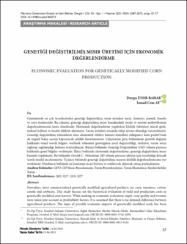Genetiği Değiştirilmiş Mısır Üretimi İçin Ekonomik Değerlendirme
Özet
Günümüzde en çok ticarileştirilen genetiği değiştirilmiş tarım ürünleri mısır, domates, pamuk, kanola
ve soya fasulyesidir. Bu çalışma, genetiği değiştirilmiş mısır hasadındaki verim ve üretim maliyetlerinin
değerlendirmesini konu almaktadır. Ekonomik değerlendirme yapılırken kârlılık faktörleri olarak girdi,
mahsul kalitesi ve hasılat dikkate alınmıştır. Tarım ürünleri arasında talep ayrımı olmadığı varsayılmıştır.
Genetiği değiştirilmiş tohumların olası ekonomik etkileri konusu mümkün olduğunca hem pozitif hem
de negatif bakış açısını kapsayacak şekilde hazırlanmıştır. Çalışmanın giriş bölümünde genetik değişim
hakkında temel teorik bilgiler verilerek tohumun genetiğinin nasıl değiştirildiği, maliyeti, verim artışı
sağlayıp sağlamadığı konusu araştırılmıştır. Birinci bölümde Genetiği Değiştirilmiş (GD) tohum piyasası
hakkında genel bilgiler verilmiştir. İkinci bölümde ekonomik değerlendirme, genetiği değiştirilmiş mısır
bazında yapılmıştır. Bu bölümde Gerald C. Nelson’nın GD tohum piyasası işleyişi için tasarladığı iktisadi
teorik model incelenmiştir. Üçüncü bölümde genetiği değiştirilmiş mısırın kârlılık değerlendirmesine yer
verilmiştir. Dördüncü bölümde ise konunun ticari boyutu ve riskleri ele alınarak sonuç paylaşılmıştır. Nowadays, most commercialized genetically modified agricultural products are corn, tomatoes, cotton,
canola and soybeans. This study focuses on the theoretical evaluation of yield and production costs in
genetically modified corn harvest. While making an economic evaluation, input, crop quality and revenue
were taken into account as profitability factors. It is assumed that there is no demand difference between
agricultural products. The topic of possible economic impacts of genetically modified seeds has been prepared in a way that encompasses both positive and negative perspectives. In the introduction part of
the study, basic theoretical information about the genetic change is given and how the genetics of the seed
is changed, its cost and whether it provides an increase in productivity has been investigated. In the first
part, general information about Genetically Modified seed market is given. In the second part, economic
evaluation is made based on genetically modified maize. In this section, the economic theoretical model
designed by Gerald C. Nelson for the operation of the GM seed market is examined. In the third chapter,
the profitability evaluation of genetically modified corn is given. In the fourth part, the commercial aspect
of the issue is handled and the result is shared.
Cilt
43Sayı
1Bağlantı
https://hdl.handle.net/11363/5604Koleksiyonlar
Aşağıdaki lisans dosyası bu öğe ile ilişkilidir:


















